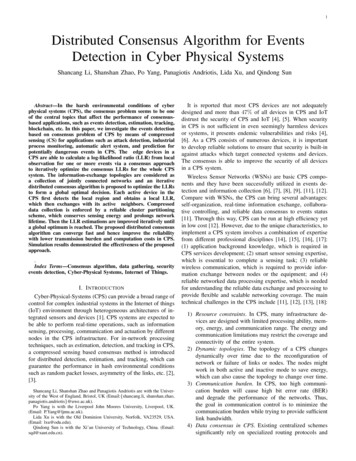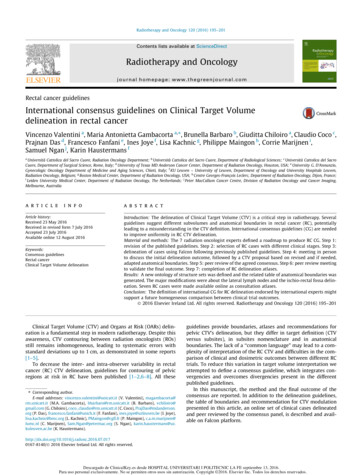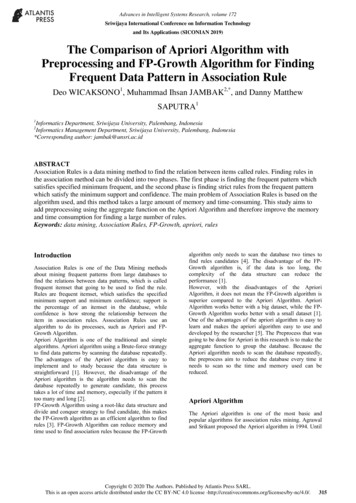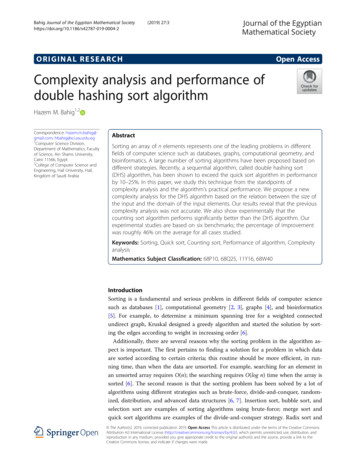
Transcription
1Distributed Consensus Algorithm for EventsDetection in Cyber Physical SystemsShancang Li, Shanshan Zhao, Po Yang, Panagiotis Andriotis, Lida Xu, and Qindong SunAbstract—In the harsh environmental conditions of cyberphysical systems (CPS), the consensus problem seems to be oneof the central topics that affect the performance of consensusbased applications, such as events detection, estimation, tracking,blockchain, etc. In this paper, we investigate the events detectionbased on consensus problem of CPS by means of compressedsensing (CS) for applications such as attack detection, industrialprocess monitoring, automatic alert system, and prediction forpotentially dangerous events in CPS. The edge devices in aCPS are able to calculate a log-likelihood ratio (LLR) from localobservation for one or more events via a consensus approachto iteratively optimize the consensus LLRs for the whole CPSsystem. The information-exchange topologies are considered asa collection of jointly connected networks and an iterativedistributed consensus algorithm is proposed to optimize the LLRsto form a global optimal decision. Each active device in theCPS first detects the local region and obtains a local LLR,which then exchanges with its active neighbors. Compresseddata collection is enforced by a reliable cluster partitioningscheme, which conserves sensing energy and prolongs networklifetime. Then the LLR estimations are improved iteratively untila global optimum is reached. The proposed distributed consensusalgorithm can converge fast and hence improve the reliabilitywith lower transmission burden and computation costs in CPS.Simulation results demonstrated the effectiveness of the proposedapproach.Index Terms—Consensus algorithm, data gathering, securityevents detection, Cyber-Physical Systems, Internet of Things.I. I NTRODUCTIONCyber-Physical-Systems (CPS) can provide a broad range ofcontrol for complex industrial systems in the Internet of things(IoT) environment through heterogeneous architectures of integrated sensors and devices [1]. CPS systems are expected tobe able to perform real-time operations, such as informationsensing, processing, communication and actuation by differentnodes in the CPS infrastructure. For in-network processingtechniques, such as estimation, detection, and tracking in CPS,a compressed sensing based consensus method is introducedfor distributed detection, estimation, and tracking, which canguarantee the performance in hash environmental conditionssuch as random packet losses, asymmetry of the links, etc. [2],[3].Shancang Li, Shanshan Zhao and Panagiotis Andriotis are with the University of the West of England, Bristol, UK (Email:{shancang.li, shanshan.zhao,panagiotis.andriotis}@uwe.ac.uk).Po Yang is with the Liverpool John Moores University, Liverpool, UK.(Email: P.Yang@ljmu.ac.uk).Lida Xu is with the Old Dominion University, Norfolk, VA23529, USA.(Email: lxu@odu.edu).Qindong Sun is with the Xi’an University of Technology, China. (Email:sqd@xaut.edu.cn).It is reported that most CPS devices are not adequatelydesigned and more than 47% of all devices in CPS and IoTdistrust the security of CPS and IoT [4], [5]. When securityin CPS is not sufficient in even seemingly harmless devicesor systems, it presents endemic vulnerabilities and risks [4],[6]. As a CPS consists of numerous devices, it is importantto develop reliable solutions to ensure that security is built-inagainst attacks which target connected systems and devices.The consensus is able to improve the security of all devicesin a CPS system.Wireless Sensor Networks (WSNs) are basic CPS components and they have been successfully utilized in events detection and information collection [6], [7], [8], [9], [11], [12].Compare with WSNs, the CPS can bring several advantages:self-organization, real-time information exchange, collaborative controlling, and reliable data consensus to events status[11]. Through this way, CPS can be run at high efficiency yetin low cost [12]. However, due to the unique characteristics, toimplement a CPS system involves a combination of expertisefrom different professional disciplines [14], [15], [16], [17]:(1) application background knowledge, which is required inCPS services development; (2) smart sensor sensing expertise,which is essential to complete a sensing task; (3) reliablewireless communication, which is required to provide information exchange between nodes or the equipment; and (4)reliable networked data processing expertise, which is neededfor understanding the reliable data exchange and processing toprovide flexible and scalable networking coverage. The maintechnical challenges in the CPS include [11], [12], [13], [18]:1) Resource constraints. In CPS, many infrastructure devices are designed with limited processing ability, memory, energy, and communication range. The energy andcommunication limitations may restrict the coverage andconnectivity of the entire system.2) Dynamic topologies. The topology of a CPS changesdynamically over time due to the reconfiguration ofnetwork or failure of links or nodes. The nodes mightwork in both active and inactive mode to save energy,which can also cause the topology to change over time.3) Communication burden. In CPS, too high communication burden will cause high bit error rate (BER)and degrade the performance of the networks. Thus,the goal in communication control is to minimize thecommunication burden while trying to provide sufficientlink bandwidth.4) Data consensus in CPS. Existing centralized schemessignificantly rely on specialized routing protocols and
2require a central fusion center, making the consensusresult unstable for networks with topology changingor node and link failures. Distributed consensus hasthe advantages of improved robustness, scalability, andefficiency.In industry, the commonly used methods to deal withthe consensus events detection are conducted through thecentralized consensus algorithms and distributed consensusalgorithms [10]. In the context of centralized consensus algorithm, fusion centers (FCs) are used to collect all nodes’measurements (i.e., log-likelihood ratio (LLR), etc.) regardingone or more target events and combine them to reach a finaldecision [19], [20]. The fusion centers are selected depends anumber of features required by applications, such as location,capacity, types, etc. In distributed consensus scheme, eachnode is able to calculate a LLR and transmit it to the FC. Forthe centralized scheme, the optimization performance dependssignificantly upon the number of nodes, if local decisions canbe correctly received at the FC [8]. If measurements fromCPS nodes are not correctively received at the FC due tomultihop transmission impairments, the detection performanceat FC can be significantly affected [19]. The centralizeddetection may also cause network congestion when the size ofCPS increases. On the other hand, sparse events detection isintimately affected by the changes of topology of CPS. In thispaper, sparse events denote events that occur very infrequentlyin sparse regions, but may cause quite dramatic consequenceswhen they do occur [16], [20], [21], [22]. Eventually, thecentralized scheme may increase the energy consumption inCPS and might be unreliable when the hop count increasesfrom node to the FC [7], [16], [17].Aiming at improving the reliability and reducing the communication burden in events detection through CPS [7], [16],[17], this paper focuses on robust events detection via adistributed consensus algorithm in CPS, in which the activeCPS nodes can collaboratively detect events and seek toiteratively reach a global optimum. In the iterative procedure[8], each node is able to exchange the detection results onlywith its active neighbors within transmission range. Distributedconsensus algorithms can be applied to overcome the problemsmentioned before [7], [16], [25], in which only local communications between neighboring nodes are involved. Throughthe iterative updates between neighboring nodes, a consensusglobal decision can be achieved at all nodes [8], where adistributed consensus algorithm with a fast convergence rateis needed. Furthermore, low information exchanges and transmission is achieved for reliable and energy-effective detectionin CPS [8], [9], [16].Specifically, a distributed consensus algorithm for sparseevents detection via a topology-changing CPS is proposed.The monitoring field is represented as a measurement vector,in which each component denotes the detection result at theposition that the node lies. Compared with nodes in a CPS,the number of events that might occur is much smaller, whichmeans the measurement vector is sparse where only a fewelements are non-zeros. This feature enables the measurementscollection by using compressed sensing (CS) based methods,for which only a few number of random sensory measure-ments from activate nodes would be enough to accuratelyreconstruct all measurements. The resolution for monitoringcan be guaranteed by solving the problem: how to obtain arobust detection result, based on the measurements of bothactive nodes and sleep nodes.Furthermore, we address the sparse events detection problem by making the following assumptions: (1) Each nodein a CPS works in two switchable modes: active and sleep(inactive) modes. Nodes in active mode can actively probe theenvironment, and nodes in sleep mode remain idle to saveenergy and they can easily switch to active mode to performdetection; (2) The number of active nodes is much less thanthose of the sleep nodes; (3) The number of events that mightoccur simultaneously is much smaller than the total numberof nodes (includes active and sleep nodes) in a CPS; and (4)The received measurements are superimposed all together frommultiple events when events might occur simultaneously. Atthe beginning of deployment of a CPS, only a random numberof nodes are configured to be in sleep mode. These nodesmight be switched into active mode or kept in sleep modedepending on the sleep strategy in topology control which isdefined by routing layer. In this paper, we skip the changesof topologies from the issues in routing layer by focusingon improving the reliability of detection and reducing thetransmission burden to save energy. First, we propose a jointlyconnected network model, in which the continuous topology ofCPS at different time t can be modeled with jointly connectedgraphs collection; then the collaborative events detection canbe formulated as a consensus optimization problem over thejointly connected networks, which can be solved as a 1 -normoptimization problem [7], [8], [9], [16]. The nodes in activemode can optimize the detection results for both itself andits neighbors in sleep mode. Each active node finally reachesconsensus for the sleep node. By this way an event can beaccurately detected even when it occurs at the point where thenode is in sleep mode. The distributed consensus optimizationproblem can be solved by alternative direction method anddetails can be found in Section II.The rest of the paper is organized as follows: in SectionII, a jointly connected network model is presented, and adistributed sparse events detection problem is formulatedas a consensus optimization; in Section III, a collaborativeconsensus algorithm is proposed; experiment simulations areprovided in Section IV to evaluate the effectiveness of theproposed algorithm; Section V concludes the paper.II. P ROBLEM F ORMULATIONA. Jointly Connected NetworksIn a CPS, consensus means that the detected states ofmultiple participants converge to the same state value for anevent. To address this problem, in this work we define eachparticipant as a node, and in a CPS nodes can communicatewith each other in its communicaton range. Consider a CPSwith N nodes and a fusion center (FC). The topology can bemodeled as a graph with the interconnection links between Nnodes, as G {V, E}, in which V {vi , i 1, . . . , N } isa set of locations of nodes L {1, . . . , N }, and E denotes
3the set of edges of the graph. Let set Na consist of all nodesin active mode, and set Ns include all nodes in sleep mode.Then we have L {1, . . . , N } Na Ns [20], [21], [22].For node i, if node j lies within its transmission range and(vi , vj ) E then one can say that node i is a neighbor ofnode j. All one-hop neighbors of i are contained in a setNi {i (vi , vj ) E}. The FC is denoted by vertex v0 . Inthis case, a CPS can be represented by a graph Ḡ with V̄ V {v0 }, which includes N nodes and vertex v0 with directededges. Note that there may not be any connection between thenodes and the FC at the moment. If one or more direct edgesfrom every node to the FC v0 can be found, then the graph Ḡis said to be connected graph or sample graph [25], [26].In CPS, a union of connected graphs {G 1 , G 2 , . . . , G m }(m 1) that have the common vertex set V̄ are defined as a unionof simple graphs [26]. For simplicity, the union of simplegraphs are denoted as Ḡ1,.,m . It is clear that Ḡ1,.,m includes avertex set V̄ and the edges of Ḡ1,.,m is the union of edges ofall simple graphs. To properly describe the union of simplegraphs, a new concept is introduced as “jointly connectedgraphs” {Ḡ1 , . . . , Ḡm }, in which each simple graph Ḡi is aconnected graph with a common vertex set V̄ and Ei mightbe different. It can be understood that a collection of jointlyconnected graphs contains at least one simple connected graph[23], [24], [26].Theorem 1. A collection of graphs {G 1 , G 2 , . . . , G m } canbe said jointly connected if its union graphs Ḡ1,.,m areconnected.Since each graph in the collection contains v0 , it guaranteesthat each graph contains at least one common node [26], [27].It should be noticed that if one or more graphs are connectedin this collection, then it is jointly connected. At a timeinterval [t, τ ], if n nodes are connected and formed a collectionof simple graphs {Ḡt , Ḡt 1 , . . . , Ḡτ }, then the graphs withdifferent topologies are said to be jointly connected.Assume a node i is able to make a local decision todetermine the occurrence of an event at a point vi , which issuperimposed of reading from its neighboring points, and canbe modeled asXxi (t 1) xi (t) wij xj (t), i W(1)j Ni (t)in which xi (t) is LLR at node i at time t, and wij is theweight between i and j.For a graph that contains a number of nodes, the linksbetween nodes change over time and that causes change ofthe topologies of the graph [28]. Let P represent a node-set,in which all simple graphs Ḡp (p P) defined on V̄ are wellindexed.The set of LLRs can be easily defined in a state vector form.For each p P, definex(t 1) (Aσ I)x(t) Fσ x(t)(2)in which x denotes a vector of LLRs: x [x1 , x2 , . . . , xN ]Tand σ : {0, 1, . . .} P is used to represent a schedulingsignal that reconfigures the networks and hence causes changesof topology at a specific time t (including CPS reconfiguration,nodes or links failures, etc.), Fσ (Aσ I), and Ap (p P)denotes the adjacent matrix of graph Ḡp .In this model, σ changes as a function of locations of theactive nodes in a CPS. Actually, the convergence analysis ofthis model is a very difficult task [29], [30]. We ignore thedependencies between σ and the node positions and instead ofthat σ can be any scheduling signal that is properly predefined.By doing this, the convergence difficulty can be avoided.The main goal is to obtain a stable global optimal decisionfrom all n nodes for any initial set of node local decision,which is expected to converge to a stable state value xS .The convergence problem of xi to xS equals to solving theconvergence problem of xS 1.For a very small P, σ remains constant make sure G is acomplete graph in p P. In this case, x can easily convergeto xS 1. Let Q denote a subset of P that consists of the indicesof the connected simple graphs in collection {Ḡp , p P} [31],[32].Theorem 2. For a scheduling signal σ : {0, 1, 2, .} P, ifx(0) is given and for all t {0, 1, . . .}, σ(t) Q holds, thenlim x(t) xS 1t (3)It is possible that a jointly connected collection of simplegraphs converges to a common decision, which has a lessstrength than that in Theorem 2. Meanwhile, Theorem 2requires the collection {Ḡσ(ti ) , Ḡσ(ti 1) , . . . , Ḡσ(ti 1 1) } in[ti , τ ) to be jointly connected. For a scheduling signal σ,Eq.(3) holds if an infinite and non-overlapping sequence ofintervals is available across which the collection is jointlyconnected. It should be noted that during interval from ti toti 1 , at least one component in Q is picked up as switchingsignal.Proof. As mentioned above, each Fp is non-negative, and allthe sums of each row of each Fp are equal to 1 (i.e., Fp 1 1).So the matrix Fp is stochastic and its diagonal elements are allnon-zeros. For a simple graph Ḡp (p Q), if m is sufficientlylarge then all entries in (I Ap )m are positive. Hence both(I Ap )m and Fp are primitive matrices, which means thatthe largest eigenvalue of Fp for p Q is 1, and all remainingeigenvalues must lie in ( 1, 1). Then we havelim Fpt 1cpt (4)for some row vector cp .It is clear that all diagonal elements of a stochastic matrixFp (p Q) are positive, and they are primitive.Theorem 3. For a finite set of ergodic matrices F {F1 , F2 , . . . , Fm }, then for a stochastic matrix Fp M,(Fp )i (i ) is a matrix of rank 1.For simplicity, a connected graph can be used to denote anetwork, and a collection of jointly connected graphs can beused to represent a set of topologies of networks, where theactive nodes may be different for different topologies.Lemma 1. For a set of jointly connected networks, let{Ḡp1 , Ḡp2 , . . . , Ḡpm }({p1 , p2 , . . . , pm } P) denote the
4corresponding topologies, then the product of matricesFp1 Fp2 · · · Fpm is said ergodic.µ2)(Aj Ak )(13)2ρUsing Eq.(12) iteratively, Eq.(11) holds and the proof iscomplete.Aj Ak (Theorem 3 can be proved as follows:Proof. For t 0, let Φ(t, t) I hold and τ be an integerbetween 0 and t, then we have Φ(t, τ ) Fσ(t 1) · · · Fσ(τ 1) ·Fσ(τ ) . Accordingly, a matrix θ(t) can be reformatted as θ(t) Φ(t, 0)θ(0). Actually Eq.(5) is enough to prove Theorem 2lim Φ(t, 0) 1c(5)t in which c denotes a row vector. According to Lemma 1,for an integer j 0, matrix Φ(tj 1 , tj ) is said ergodic,and it can be represented by a product of finite matricesfrom {Fp , p P}. Accordingly, Φ(tj , 0) can be substitutedby Φ(tj , tj 1 )Φ(tj 1 , tj 2 ) · · · Φ(t1 , t0 ). Therefore, Φ(tj , 0)is ergodic and we havelim Φ(tj , 0) 1c(6)j Let jt denote the largest non-negative integer that satisfiestjt t. Accordingly, Φ(t, 0) can be represented by the productof Φ(t, tjt ) and Φ(tjt , 0), and we haveΦ(t, 0) 1c Φ(t, tjt ) · (Φ(tjt , 0) 1c)(7)It can be seen that Φ(tjt , 0) 0 when t due to Eqs(5) and (6), therefore Eq.(4) holds and the proof is complete.For two non-negative matrices Fi and Fj , if all elementsof Fi Fj are non-negative, then matrix Fi Fj is said anon-negative matrix.Proof. (Lemma 1) Let a non-negative matrix F (I A), inwhich A denotes the adjacency matrix of the collection beingjointly connected graphs {Ḡp1 , Ḡp2 , . . . , Ḡpm }. Then matrix Fis said primitive. According to Lemma 2 we haveFp1 · Fp2 · . . . · Fpm ξ(Fp1 Fp2 · · · Fpm )(8)in which ξ denotes a small positive constant. Then for aprimitive matrix Fpi , Fpi (I Api ) holds, andFp1 · Fp2 · . . . · Fpm ξ(mI Ap1 Ap2 · · · Apm ) (9)Since m is an integer then mI I holds and Eq.(9) isreduced toFp1 · Fp2 · . . . · Fpm ξF(10)It should be noticed that the product is bounded below byξF , and the product is primitive as well. As mentioned in [16],[17] the product is also a stochastic matrix, so it is ergodic[26], [33].Lemma 2. For an m m non-negative set Ai , i {1, 2, · · · , m}, let µ denote the smallest diagonal element ofAi and ρ denote the largest diagonal elements of Ai . We haveµ2 (m 1))(A1 A2 · · · Am ) (11)2ρProof. This can be easily proved by writing Ai as Ai µI Bi , where Bi is non-negative. For any j, kA1 A2 · · · Am (Aj Ak (µI Bi )(µI Bi ) µ2 Since (ρI Bj ) Aj and (ρI Bk ) Ak , then we haveµ2(Bj Bk )2ρ(12)B. Jointly Connected Graphs based Consensus AlgorithmFor a collection of jointly connected networks, each nodeis capable of exchanging information with its active neighborsdirectly and keeping all the local LLRs vector in the networkto derive a weighted average, which eventually converges toa global decision vector [34], [35].As proved in Theorem 2, for x(t 1) Fσ x(t), weightmatrix Fσ features the sparsity pattern specified by thejointly connected graphs collection {G 1 , G 2 , . . . , G m } and σ :{0, 1, . . .} P, in which weight matrix Fσ correspondingto the edges of connected graph. For a t-step transition matrixΦ(t) Fp1 Fp2 · · · Fpm , we havex(t 1) Φ(t)x(0)(14)and according to Theorem 2, we have1(15)lim Φ(t) 11Tt nwhich is equivalent to 1 lim x(t) 1T x(0) 1(16)t nThe weight matrix satisfies the condition in Eq.(16). In practice, some links might fail permanently, however the jointlyconnected scheme guarantees the long-term connectivity ofgraphs [36], [37].III. D ISTRIBUTED S PARSE E VENTS D ETECTIONWhen an event occurs around a local node vj , it mightinfluence its neighboring area by a non-zero influencefunctionPwj (vj ), which can be normalized to obeywj (vj ) 1[33]. Let yi denote the measurement at point vi that is thesuperposition of the influence of all events on vi . LLR will beobtained at vj , and we have wji wij , which is the weightevent at vi . Let i denote the measurement noise of zero mean.It is easy to understand that the LLRs vector x is sparse, butthe measurement vector yi can be non-sparse.For a CPS with Na (t) active nodes and Ns (t) inactive nodesat time t, measurement yi at vi can be modeled asXyi Aj,i xj i(17)j Nin which Ai,j Aj,i denotes the influence event at vi .For node i, if node j is out of the transmission range ofi, then let Aji 0. Accordingly,the observation yi can bePrepresented as yi xi j n Aj,i xj i . Furthermore, fora network with Na active nodes, we haveya ΦAx a(18)in which Φ denotes the selection matrix, ya denotes themeasurement vector and a denotes the noise, respectively.
5Here compressed sensing can be used to perfectly recoverx from measurements ya [7], [8]min kAx ba k22 λkxk1 s.t. x 0(19)xThe neighbors list of node i is denoted by Ni . Node i notonly keeps xi at vi , but also keeps measurements xk ( k Na Ni ) that is evaluated at its inactive neighboring nodes.Actually, neighbors of i include active nodes belong to Ni Naand the sleep nodes belonging to Ni Ns . Then we rewriteEq.(19) asminX (i)Xyi xi (i)Ak,i xk k Ns Nii NaXs.t. 2j Na λkxk1(i)xi(i)xk(j)Ak,i xj(20a) 0, i Na ,(20b) 0, k Ns Ni(20c)Note that here kxk1 can be solved byX (i)X(i)kxk1 xi xk(21)i Ns Nkiin which Nk denotes the active neighboring nodes at vk and(i)(i)both xi and xk are non-negative constraints for all decisionvariables.A. Collaborative Consensus OptimizationIt is crucial to perform collaborative detection by fusing yto obtain a global optimal estimation of the sparse decisionx. For a CPS with N Na Ns nodes and a FC, xcan be reconstructed from the following 1 -norm optimizationformulationXX (i)X(i)mina2i xi xk(22a)i Ns Nkii Na(i)Xs.t. ai yi xi k Ns Ni(i)Ak,i xk X(j)Ak,i xjj Na(22b)(i)xi(i)xk 0, i Na ,(22c) 0, k Ns Ni(22d)Eq.(22) might yield a globally optimal result, in which thelinear measurements from all the nodes are centrally fused atthe FC. It is costly but easy to be implemented. Not only allmeasurements, but also the measurement matrices of all nodesneed to be collected at FC.Let J denote the number of active nodes, then the problemreduces to J least-squares sub-optimal functions. This maycause a very expensive computation cost when the number ofnodes increases.min kxk1 xJXλj ky(j) Ax(j) k22(23)j 1where the positive parameter {λi } describes the noise reP(j)silience of the samples {xt } and λ j λi describesthe trade-off between noise resilience and events sparsity. Asmentioned above, the centralized fusion may cause high communication burden and hence cause unstable optimal resultsand high energy consumption.A distributed consensus algorithm may overcome the drawbacks of centralized consensus fusion, which uses only localoptimal between one-hop neighbors to iteratively estimate thedecision. In this case, each active node j keeps a local copy(j)of the local decision xj and collaboratively consent on theircopies [16], [35]. Let G {G1 , G2 , · · · , Gm } be a collectionof jointly connected networks depicting the connectivity ofthe CPS, in which each network Gi (Vi , Ei ) includes activenodes for the set of vertices Vi (i 1, . . . , m) and each edge(j, k) Ei connects an unordered pair of distinct nodes withinone-hop neighborhood. Different from the centralized fusionformula, each node j locally performs the following consensusoptimizationmin kx(j) k1 λj kx(j) Ax(j) k22x(j)(24)It can be seen that Eq.(24) enforces the consensus betweenj and its one-hop active neighbors, which can be solved asa LASSO problem [17], [34]. Each local LLR at an activenode is shared with its one-hop neighbors and will be updatedand percolated throughout the network after performing aniterative consensus procedure that converges to an optimalresult. Upon convergence, all neighboring nodes will haveconsented Pon theP same globally optimal x. It can be seenthat when j k wjk 1, Eq.(24) forces the LLR copy xjto consent to a weighted neighboring LLR by a reminiscentphase. Thus, the weighting matrix A can be easily obtainedby setting its (i, k)-th element as wjk by adhering to A1 1,where 1 is the all-one vector.B. Distributed Consensus Implementation via the AlternatingDirection Method of MultipliersThe iterative optimization can be implemented via theglobal consensus discussed above. For Eq.(24), an augmentedLagrangian function can be created as L x(j) , λj , zj , {x(j) } ky(j) A(j) x(j) k22 zTj x(j)Xβwjk x(k) k22 (25) kx(j) 2k Njwhere zj denotes a Largrangian operator, and β denotes theaugmented Lagrangian multipliers in the consensus optimization constraints. zTj x(j) is applied to guarantee that Eq.(25) isPfulfilled by properly setting zT (x(j) k Nj wjk x(k) ) 0.By using the alternating direction of multipliers, each nodecan update x(j) (t) by iteratively solving x(j) arg min L x(j) , λj , zj , {x(j) }(26)x(j)in which the multipliers can be updated via a gradient-basediteration Xβ (j)z(j) (t) z(j) (t 1) x wjk x(k)(27)2k Nj
6Algorithm 1: Distributed Fusion Algorithm(j)Input: Each node calculates LLR as xt , sets λj and cempirically, initializes estimate x(j) (0) 0 andlocal multiplier vector z(j) (0) 0. Let T be themaximum number of iterations and e be thetolerable deviation, both are at convergenceconditions.Output: Algorithm converges to an optimal result andeach node obtains the global estimationx x(j) (T ), j N .repeat(j)All nodes update z(j) (t) and xt via Eqs (26) and(27), j;(j)All nodes transmit xt (t 1) to their one-hopneighbors in Nj , j;t t 1.(j)(j)until t T or kxt (t 1) xt (t)k e;In Eqs (26) and (27), the iterative steps constitute a distributed scheme, and details can be found in Algorithm 1.In the t-th iteration, a node j first collects x(j) from itsone-hop neighbors k Ni , which is then used to updatethe local multiplier vector z(j) (t) as described in Eq.(27). Bydoing this, Eq.(26) can be solved as a quadratic optimizationproblem and the updated local LLR estimation x(j) (t 1)will be yielded. Then, all nodes locally update the decisionand exchange the sparse estimation x(j) (t 1) with their onehop neighbors. This procedure repeats until converged to thespecific condition.During iterations, nodes are not required to synchronize themeasurements, which makes it easily implemented in a largescale CPS. The convergence of Algorithm 1 can be proved asfollows:Proof. In [17], the iterative alternating direction method havebeen proved to converge to a minimizer of Eq.(26) for anypositive constant β.IV. P ERFORMANCE E VALUATIONIn this section, a CPS will be created to perform thesparse events detection using proposed distributed consensusalgorithm. Considering an event detection scheme in a smallnetwork with 5 nodes (ni , i 1, . . . , 5), which are deployedin a two-dimensional area and the distance between twoneighboring nodes is 20, and communication range is 50 asshown in Fig.1.It can be seen that the neighbor-set of n1 includes nodes{n2 , n3 }. Similarly, n2 has a neighbor-set as {n1 , n3 , n4 }, n3has a neighbor-set as {n1 , n2 , n4 , n5 }, n4 has a neighborset as {n2 , n3 , n5 }, and n5 has a neighbor-set as {n3 , n4 },respectively. As mentioned in Section III, each node does notonly hold its local decision, but also holds the decisions of itsneighbors (both active and sleep neighbors). Let ci denote thepossibility that event might occur at the position that ni lies(vi ), and all five nodes are in active mode. Assume that threeevents occurred at v1 , v3 , and v5 , respectively. The detectionFig. 1. Consensus algorithm on 5 active nodesTABLE ID ETECTION RESULTS AFTER 200 lts from all five nodes are reported in Table I, where thepossibilities of events occurred are reported and N/A meansthat the detection is not available. For example, node n1 cansuccessfully detect events occurred at n1 , n2 , n3 , but cannotdetect events occurred at n4 and n5 . It is reasonable that nodesn1 , n2 , and n3 are in the neighbors list of n1 .Fig.2 presents the optimization results when all n
Lida Xu is with the Old Dominion University, Norfolk, VA23529, USA. (Email: lxu@odu.edu). Qindong Sun is with the Xi'an University of Technology, China. (Email: sqd@xaut.edu.cn). It is reported that most CPS devices are not adequately designed and more than 47% of all devices in CPS and IoT distrust the security of CPS and IoT [4], [5]. When .











